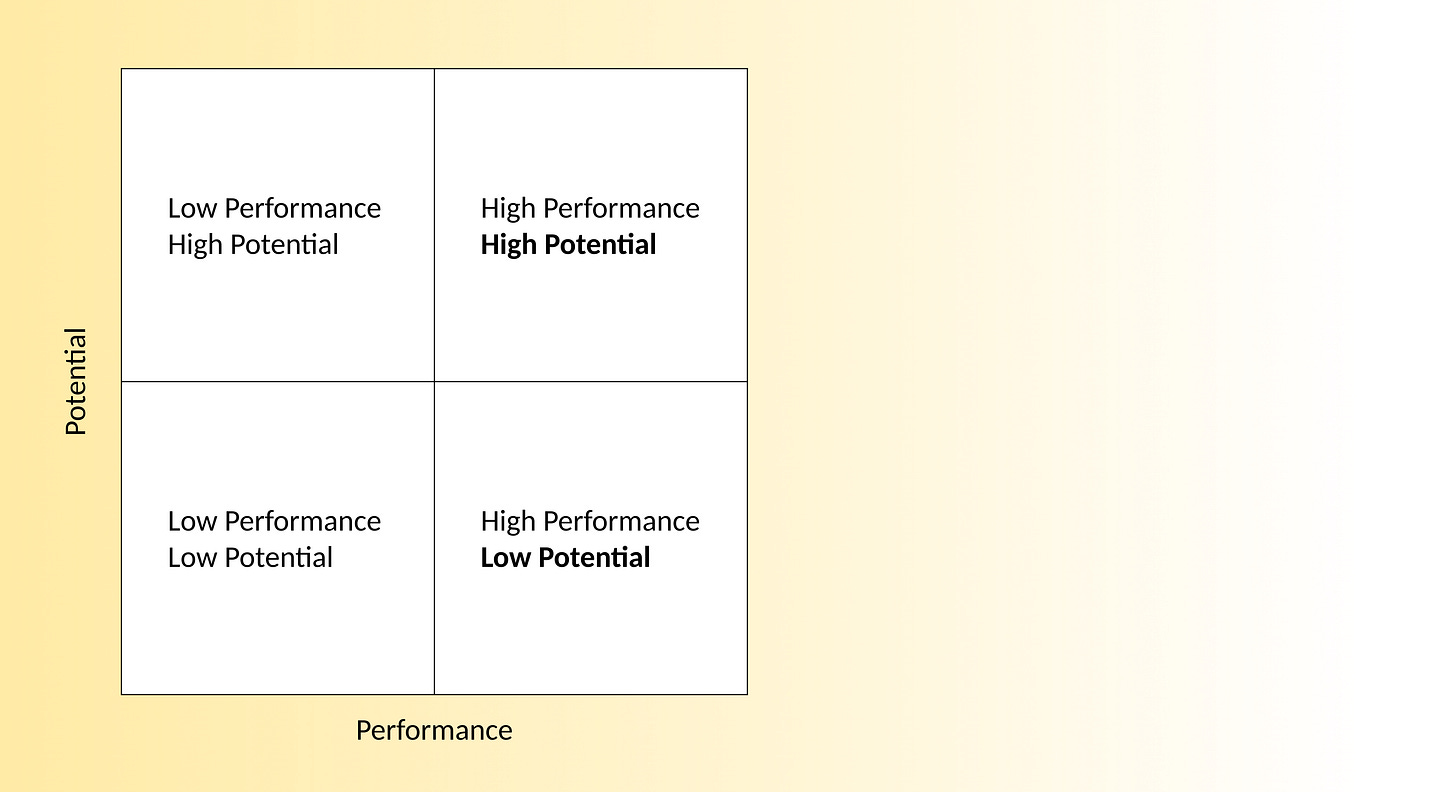When Your Strongest PMs Hold You Back
Spotting High Performance // Low Potential Before it Calcifies Your Roadmap
The 2x2
Every product leader evaluating their team has sat in front of a 2x2 at some point with performance on one axis, potential on the other. It’s a neat mental model and pairs well with a competency artifact. Your job? Hire the upper right, weed out the lower left, and coach the others. Easy, right?
But if you’ve used it to evaluate a product team, you’ve probably asked yourself the same question I did: What is “potential,” anyway?
Performance we can measure! Shipping on time, hitting metrics, running clean sprints. Potential is slipperier. It’s harder to see in the moment. But it matters even more, because your roadmap will eventually inherit the qualities of your people.
People shape bets, and bets shape growth.
What “Potential” Looks Like in Product People
Potential is about whether that person can grow the team, the roadmap, the business. You’re looking for repeated patterns, not isolated wins. Here are the patterns that often separate the High Potential PM from the Low Potential PM:
Appetite for Ambiguity. Energized by creating clarity from messy, undefined problems.
Anti-pattern: Shine when problems are well-scoped, but freeze when the walls disappear.Reframe from First Principles. Zoom out, reframe, ask: “Why are we solving this at all? What makes this the most important problem? How might we…” Will toss a polished plan if it’s the wrong plan.
Anti-pattern: Anchor on best practices or copycat solutions. Optimize within the frame, but never break it.Connect to the Bigger Picture. Articulate how their work ladders to business outcomes, customer value, and long-term bets.
Anti-pattern: Can explain what shipped and which metric moved, but not why it matters in the larger system.Cast Vision, Ship Versions. Hold the dream and the tactical next step in creative tension. Can flex up into vision and down into backlog grooming seamlessly and take the team along.
Anti-pattern: Excel at one (usually execution), but rarely stretch across both.Learning → Action Loops. Seek out critique, adapt when the ground shifts, and show evidence of compounding. Every cycle makes them sharper.
Anti-pattern: Learn just enough to execute the current task. Thrive when the plan holds, struggle when it doesn’t.
The “Low Potential” PM
Patterns are what define this quadrant — repeated freezing, repeated lack of reframing, repeated avoidance of the bigger “why.” Over time, you start to see the profile:
Excellent at executing well-scoped tasks
Reluctant (or unable) to zoom out, connect dots, or explore beyond the brief
Motivated by polishing the known, not venturing into the unknown
They’re dangerous because they can look like your best people for a long time. They’re consistent. They deliver. Stakeholders love them because requests get done quickly and cleanly. But here’s the catch:
They generate momentum, not velocity. The train runs on time, but it’s stuck on the same tracks.
They calcify the roadmap. Incremental wins pile up while bigger bets languish.
They teach the wrong lessons. New PMs learn “execute fast and clean” instead of “reframe, test, and grow.”
To spot potential during hiring and coaching:
Watch for generative thinking. Do they create new options, or do they optimize the options you gave them? If they can’t zoom out, they won’t stretch your roadmap.
Look for learning velocity. Ask about a time they were dead wrong and what changed in their approach afterward. High potential PMs can show compounding growth; low potential ones give you a canned failure story.
Insert ambiguity. Give them a project where the outcomes aren’t obvious and success can’t be reduced to a single metric. Do they generate hypotheses, or just wait for you to define success?
Force reframing. Ask them to articulate the “why” behind a roadmap arc or for the story behind an investment. If their answer is “because sales asked” or “because the metric dropped,” nudge them higher up the chain.
Model compounding. Don’t just debrief the project. Ask: “What did we learn here, and how should it change our playbook going forward?” High potential PMs carry the lessons forward — the next roadmap cycle looks different because of the last. Low potential PMs will rinse and repeat.
If after repeated chances they still can’t flex, then they’re executors (though, useful in some contexts).
Why This Matters
If your team is stacked with high performance / low potential PMs, your roadmap will look similarly: Polished delivery, little true progress. What looks like a well-oiled machine is actually a machine that can’t turn, can’t experiment, and can’t chase compounding returns.
As AI takes on more of the rote execution — the scheduling, the sprint hygiene, even the spec drafting — the premium on potential only grows. Machines can crank. People need to create, reframe, and teach others how to see differently.
Bottom line: High performance without potential is a mirage. It feels good in the moment, but it quietly locks your roadmap — and your org — into incrementalism. Spot it, coach it, or cut it before it calcifies.



